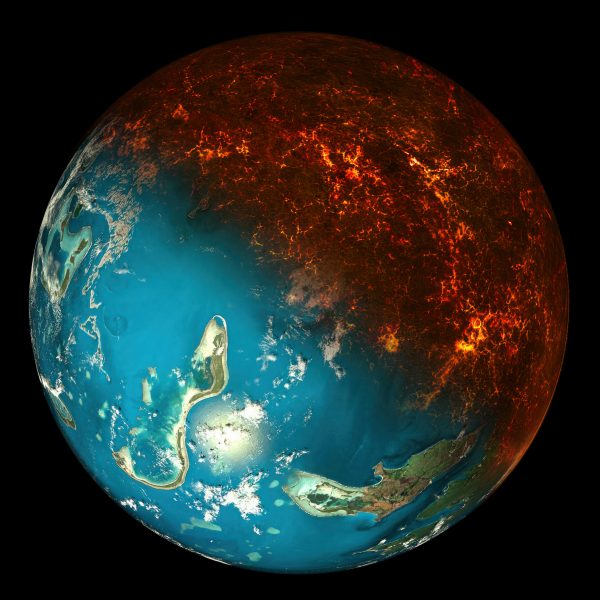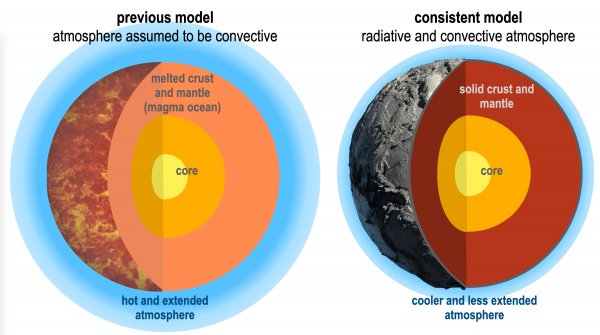A hellish childhood difficult to model.

A team of French and Swiss scientists, including astronomers from the University of Geneva and the National Centre of Competence in Research (NCCR) PlanetS, has published a study leading to rethink what we know about the first climate of the Earth, back when it was still covered in lava. The study, published in the journal Nature, not only impacts the history of our planet, but also that of our sister planet Venus and Earth-like planets around other stars than the Sun.

Shortly after their formation, Venus and Earth were covered by an ocean of magma, as were some recently discovered exoplanets.
A hellish childhood
Around 4.6 billion years ago, the infancy of our solar system was far from a smooth ride. Bathed in the cloud of gas and dust that formed them, protoplanets are constantly bombarded by asteroids and white-hot by the radioactivity of their interiors.
Consider the Earth and its close neighbor Venus. Temperatures there are much higher than today, so high that an ocean of magma covers their surface. The primitive atmosphere that envelops them is saturated with water, which in these conditions can only exist in gaseous form.
Difficult modeling
“The conditions that prevailed on the two young planets are also being studied today in the context of exoplanet research,” explains Guillaume Chaverot, PhD student at the University of Geneva, member of the PlanetS National Centre of Competence in Research (NCCR) and co-author of this new study on the subject. “Astronomers have discovered water-rich planets whose atmospheres may be saturated with water vapour. Modeling them consistently is difficult because the typical evolutionary time of the upper layers of the atmosphere is much shorter than that of the lower layers”, says Guillaume.
Studying the evolution of these planets is a real challenge for scientists. Indeed, to model an atmosphere, we need to take into account the physical processes of interaction between light and water molecules. As the atmosphere here is thick and water is a powerful greenhouse gas, this becomes difficult and requires sufficiently powerful computers.
An assumption to make the calculations easier…
The solution found in the 1980s for the Earth and Venus was to assume that heat transfer in the atmosphere was due to the motion of air masses, rather than the interaction of light and gas molecules. Scientists speak of convective atmospheres. This hypothesis is also commonly used today for exoplanets or to model the Earth’s current atmosphere.
With this hypothesis, Venus could have kept its magma ocean for a long time, and seen its water gradually evaporate into space under the influence of solar radiation. The Earth, being a little further from the Sun, saw its temperature drop sufficiently to allow the solidification of its crust and the condensation of water in its atmosphere, leading to a veritable deluge, forming the first oceans. This allowed water to remain on the Earth’s surface, providing a suitable environment for the emergence of life. The Earth is in a temporary state, however, as the flow of solar energy increases as the Sun ages, allowing the oceans to vaporize. Using convective atmospheric models, a runaway greenhouse effect due to this water vapor will then generate surface temperatures high enough to cover the Earth with a new ocean of magma.
…but an erroneous assumption
Now, however, a Franco-Swiss team has challenged the hypothesis of a convective atmosphere for this type of planet. In a paper published in the journal Nature, the astronomers show, on the contrary, that radiative processes (i.e. interactions between light and atmospheric layers) play an important role, particularly in heat transfer and the ability of these planets to cool down.
“With this new analysis, we deduce that the magma ocean on Venus would have had a much shorter existence than initially expected,” announces Emeline Bolmont, Assistant Professor at the University of Geneva, Director of the Center for Life in the Universe, member of the National Center of Competence in Research (NCCR) PlanetS and co-author of the study. “Similarly, the increase in solar flux will not allow a temperature high enough to melt the Earth’s crust and create a new ocean of magma on the Earth’s surface,” continues Emeline.
For exoplanets, the erroneous assumption of a convective atmosphere means that the radius of planets with water-rich atmospheres is overestimated. This is the case for planets in the TRAPPIST-1 system, such as TRAPPIST-1 b, whose radius is overestimated by 4 to 6% compared with the new coherent model taking radiative processes into account.

The old model, which neglects radiative processes in the atmosphere of water-rich planets, overestimates the size of the atmosphere and therefore the radius of the planets. (Credit: F.Selsis)
With great consequences comes a long validation process.
The new results call into question recent strategies for observing exoplanets. Indeed, given the limited observing time available on the world’s major telescopes, it is not possible to observe all exoplanets to determine whether or not they have an atmosphere, and if so, to observe them to characterize their physical parameters. Astronomers select the best candidates for observation based on their mass and radius, in order to limit the risk of non-detection (absence of atmosphere or atmosphere too thin) and maximize telescope use. However, some planets selected on the basis of the obsolete model are likely to have their radii revised downwards, calling into question their status as favorite targets for atmospheric studies.
Planetary scientists and astronomers are also going to rethink their ideas about the infancy of the Earth and Venus. Challenging a decades-old hypothesis is no easy task, especially when it has so many consequences. As a result, the study underwent a thorough re-reading by other specialists. Four reviewers instead of the usual two or one asked the Franco-Swiss team to carry out numerous tests to verify and consolidate the new model. A lengthy process, essential to guaranteeing quality science, which culminated in the acceptance of the research paper and its publication in the prestigious journal Nature.
Reference:
Selsis, F., Leconte, J., Turbet, M. et al. A cool runaway greenhouse without surface magma ocean. Nature 620, 287–291 (2023). https://doi.org/10.1038/s41586-023-06258-3

